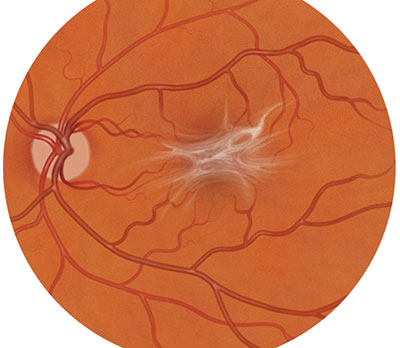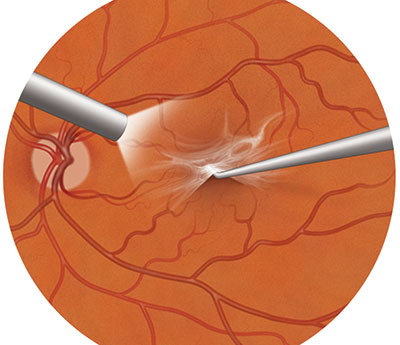Macular pucker (also called epiretinal membrane) happens when wrinkles, creases or bulges form on your macula. The macula must lie flat against the back of your eye to work properly. When the macula wrinkles or bulges, your central vision is affected.
With macular pucker, things can look wavy, or you may have trouble seeing details. You might notice a gray, cloudy, or a blank area in your central vision. You may even have waviness in your central vision where straight lines look crooked or wavy. Macular pucker will not affect your peripheral (side) vision.
What causes macular pucker?
Age is the most common cause of macular pucker. As you get older, the vitreous begins to shrink and pull away from the retina. Usually the vitreous pulls away with no problems. But sometimes the vitreous can stick to the retina. Scar tissue forms, causing the retina and macula to wrinkle or bulge.
Who is at risk for macular pucker?
Aging is the most common risk factor for macular pucker. People who have other eye problems may also get a macular pucker. These problems include:
Diagnosis
Your ophthalmologist will put drops in your eye to dilate (widen) your pupil. This allows them to look through a special lens at the inside of your eye.
Then they will take pictures of your eye using optical coherence tomography (OCT). With OCT, a machine scans the back of your eye. This provides very detailed pictures of the retina and macula. Your ophthalmologist studies these pictures to check for problems.
Treatment
How you are treated depends on your symptoms.
If your symptoms are mild, you might not need any treatment. Instead, your ophthalmologist may change your glasses or contact lens prescription to improve your vision. You might also choose to wear bifocals when you are looking at something close. Eye drops, medicine, and laser surgery do not help vision if you have macular pucker. However, your ophthalmologist may prescribe these treatments if you have other conditions mentioned above.
If your symptoms are more serious, your ophthalmologist may recommend a surgery called vitrectomy with membrane peeling. Your ophthalmologist will remove some of the vitreous and scar tissue on your macula. This flattens the macula, returning it to its proper position. It is likely your vision will slowly improve. However, your sight may not be as good as it was before macular pucker.

Macular pucker before surgery.

Your ophthalmologist uses tiny instruments to remove the wrinkled tissue on the macula.
What are vitrectomy surgery risks?
Like all surgery, vitrectomy has some risks. They include:
- Eye infection
- Bleeding in your eye
- A detached retina (where the retina lifts away from the back of the eye)
- Having the macular pucker happen again
- Cataract, when the lens in your eye becomes cloudy
Your ophthalmologist will talk about these risks and how vitrectomy surgery may help you.